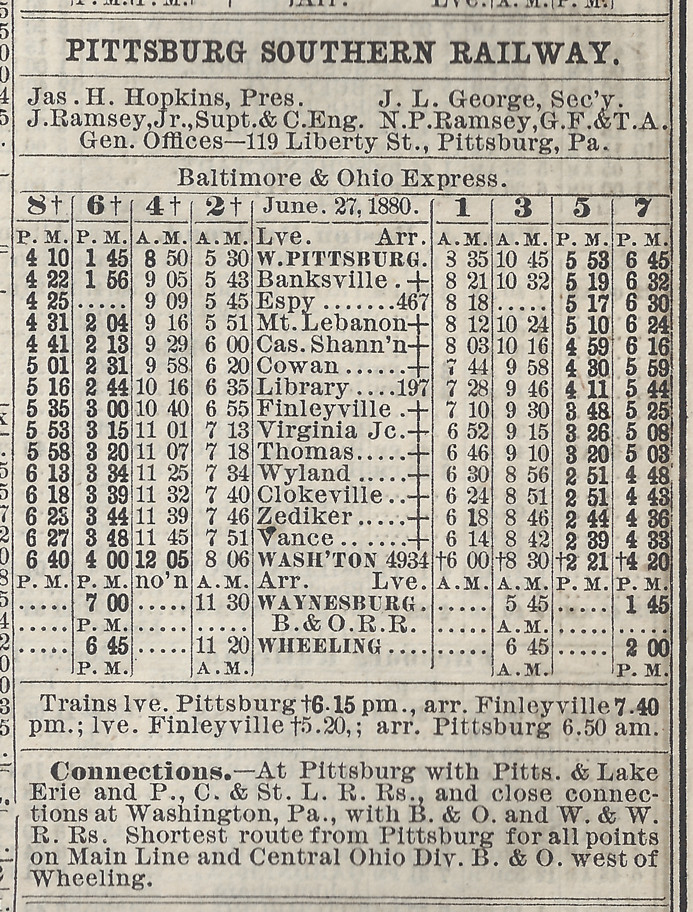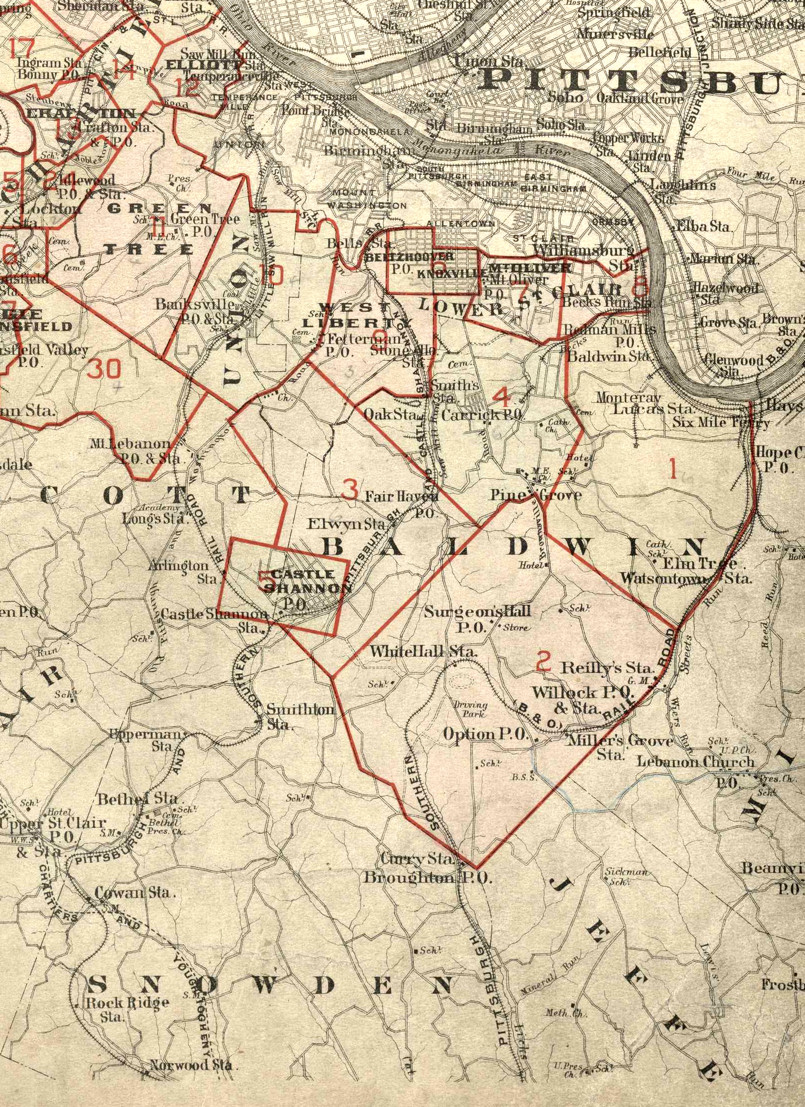
Notes on the Pittsburgh Southern Railroad
A Lost Road
The charter of the Pittsburgh and Castle Shannon Railroad allowed construction as far as Finleyville in Washington County. When the directors refused to build further south than Castle Shannon, company president Milton Hays organized another company in 1876, the Pittsburgh, Castle Shannon and Washington Railroad, which was reorganized in 1878 under the name Pittsburgh Southern Railroad. Hays at first saw it as an extension of his P&CS company, and it was built to the same forty-inch gauge to permit through trains.
The PCS&W opened in December 1877 from Castle Shannon to Library. These end points will give the impression that it followed the same path as the future Charleroi interurban line (the present-day T), but it did not. Its route was instead similar to that of the Washington interurban as far as Drake in the town of Upper St Clair, whence it turned southeast and ran over the hills and down the valley of the Piney Fork to Library. It was extended to Finleyville in 1878, again not following the same route the interurban would take. Under the name Pittsburgh Southern the railroad was completed in February 1879 to Washington, the largest town on the line.
As president of P&CS, Hays had authorized use of P&CS equipment to build the new railroad, and it was operated with P&CS locomotives and passenger cars. But the directors were not happy with Hays's spending on another railroad, even though it delivered passengers and freight to the P&CS. The dispute sparked off a "railroad war" in May 1878, when the PCS&W was operating as far as Finleyville. The P&CS would no longer accept PCS&W tickets and would not allow trains to run through, so PCS&W trains terminated at Arlington yard. Worse, the P&CS gave thirty days' notice cancelling the use of their rolling stock. That really put Hays in a bind because new or used equipment for the odd forty-inch gauge was not readily available. And Hays himself was out of the P&CS.
But he had some ideas. He very quickly made a deal with the Little Saw Mill Run Railroad, which ran from Temperanceville on the Ohio River to Banksville, and started what had to be very makeshift construction of a three-mile link over the hill from Banksville to Arlington. He moved his rails inward by four inches so that he could use second-hand three-foot gauge equipment, and laid a third rail on the standard-gauge Little Saw Mill Run. It is hard to believe that all this was done in a month. To mark his separation from the Pittsburgh and Castle Shannon he renamed the road the more pretentious Pittsburgh Southern Railroad. The extension to Washington was completed as three-foot gauge under the Pittsburgh Southern name, and there were even plans to run south as far as West Virginia.
Hays's spending spree was not sustainable by the light traffic the railroad got, and the rather poor civil engineering, with its many curves and bad grades, made it expensive to operate per mile. Just four months after completion, in April 1879, he had to sell off the property. Under new ownership it became the Pittsburgh Southern Railway (instead of Railroad). It somehow eked out an existence for another four years. Then in January 1883 the Baltimore and Ohio Railroad bought a controlling interest in the company.
But the B&O connection had started before that. A timetable dated as early as June 27, 1880, credits the Baltimore & Ohio Express with parcel delivery service on the road, and it shows timings for connecting trains to Wheeling, West Virginia, with the notation "Shortest route from Pittsburg for all points on Main Line and Central Ohio Div. B. & O. west of Wheeling". The other connecting service was the Waynesburg and Washington Railroad, another narrow gauge line, which the B&O ignored.

To explain the B&O's interest requires a little bit of railroad history. Against opposition from Pennsylvania Railroad interests, but with support from shippers who expected competition to lower freight rates, the B&O completed a Baltimore-Pittsburgh route in 1871 by acquiring the Pittsburgh and Connellsville Railroad, which was built in parts starting as early as 1855 but which was only completed to meet the B&O at Cumberland in 1871. While the P&C had an enviable route along the right bank of the Monongahela into Pittsburgh— it was chartered so early that it had blocked the Pennsylvania Railroad from that path— the down side was that by the time the B&O was ready to expand west from Pittsburgh a few years later, there were established routes along both sides of the Ohio River. The B&O was therefore forced to create two awkward routes that involved leaving Pittsburgh travelling east and then curving around to the north or south. Both were completed in 1884. The northern route, the Pittsburgh Junction Railroad, does not concern us here.
The B&O used the Pittsburgh Southern charter to construct a new railroad branching off at Glenwood, almost five miles east of the Pittsburgh terminal. It crossed the Monongahela on a great bridge, ran a few miles in the valley of Streets Run, and then curved its way through the hills to reach Finleyville on the original Pittsburgh Southern. It was really the portion from there to Washington that the B&O wanted. At Washington the railroad met the Hempfield Railroad, which was opened from Wheeling in 1857 and acquired by the B&O in 1871. The original B&O itself had been completed through West Virginia to Wheeling in 1853, and from there it ran west, eventually to Chicago and St Louis.
The Pittsburgh Southern from Finleyville to Washington was obviously converted to standard gauge in 1883 in order to make through B&O service possible. The remainder of the PS was never converted to standard gauge and was abandoned in 1884. The B&O had no use for it. The Pittsburgh Southern company was renamed the Baltimore and Ohio Short Line Railroad in 1885. Its route from Glenwood to Washington was shortened in 1900 by the completion of the Whitehall Tunnel.

So what's left of the old PS?
1: The Red Line right of way from Mt Lebanon to Arlington stop might be on the Pittsburgh Southern alignment. By the time Pittsburgh Railways built the line in 1903, the PS was gone for almost twenty years, and the land had been sold off to many owners. Was a graded route still there for the taking, or did the hilly topography simply dictate use of a very similar route?
2: The Blue Line running for two blocks between the lanes of Willow Avenue, south of Willow stop, was explicitly said to be a remainder of the PS in a lawsuit later. The P&CS bought this short section for sidings when the PS was abandoned.
3: The Baltimore and Ohio Railroad from Finleyville to Washington is still in use as a freight branch line.
For the rest, the locations on my map are speculative. The best source I could find is the index map of a Hopkins atlas dated 1896, here. Click "Full Version of the Index Map" to see all of it, or just look at my detail from it above. It's clearly part of a larger map— notice how it is cut off at the bottom. Despite the date of the atlas the map itself must be from 1883 or 1884 since it shows the "Pittsburgh and Southern" (sic) still in place from top to bottom on the left, and it also shows, on the right, the route built under Baltimore and Ohio auspices. My attempts to overlay this map on modern maps convinced me that it is not really to scale, and so it cannot be used to locate the PS precisely. But I assume that the places where it crosses roads are likely to be correct in relation to the roads, and I assume that the railroad's builders tried to find reasonable grades, and based on both assumptions I have made a bold attempt at drawing its possible location on my map. It does not help confidence to see that Long's station is misplaced on this map, judging by a timetable that has, north to south, Banksville, Long, Mount Lebanon, and Cemetery, the last of which would logically be near where the map has Long's.
The Little Saw Mill Run Railroad is well documented on old maps including the one above. It began on the Ohio at Temperanceville— soon renamed West End when drunks moved in. The PS expected passengers from Pittsburgh to start their journey by boat to a landing that may have been a short distance up the Saw Mill Run. The LSMR lasted much longer than the PS, becoming part of the West Side Belt Railroad in 1897. The first mile from West End to West Belt Junction was in use until 2009. The remaining two miles down to Banksville closed earlier and were obliterated by construction of US 19 in 1951.
Below Banksville the route is a mystery beyond the Hopkins map and stations documented in surviving Timetable No. 6. Abandoned railroads normally leave physical features like grades, buildings, and bridge abutments, and more subtle traces like odd property lines. Not the PS. You'd never know it was there. The quickly built section from Banksville to Arlington is especially puzzling because it had to go up and over the hill at Mt Lebanon, so you'd expect to find remains of cuts and fills and hillside grades, but there is no sign of any of that. Of course it was built in a month. South of Library, we don't even have the Hopkins map for guidance. Because the PS station list includes Simmons, the name of the interurban stop now called Library, I assume it ran that far, and because the next station is Saulsbury, a property owner on the Finleyville Road, my guess is that the route was similar to that of Cardox Road. Just as we approach Finleyville we have the guidance of someone's hand drawing on a copy of the Washington County atlas of 1876.
The Finleyville-Washington section, which is still in use, seems somewhat better engineered than a railroad that left no trace. There are even two tunnels. I wonder how much is B&O improvements.